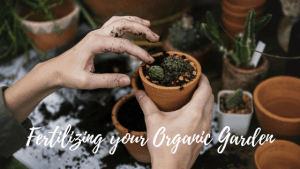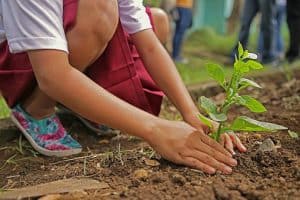In general, organic fertilizers come from plants, animals, or minerals. The material gets broken down by soil organisms into nutrients that plants can utilize. Organic fertilizers usually contain significant amounts of only one major nutrient and some traces of many other beneficial nutrients. A bone meal, for example, contains large amounts of phosphorus and some small amounts of trace nutrients.

Some gardeners opt to add organic material that improves soil structure and supports microorganisms present in the soil, which helps the nutrients to be available more quickly. This is especially true in warm weather when these microorganisms are more active. Generally, organic fertilizers release half of their nutrients during the first season and will continue to feed the soil over the succeeding years. They build up soil health over time, which is a big advantage of organics.
So what kind of fertilizers should you use on your organic garden? Keep reading and learn more.
Plant-based fertilizers
Plant-based fertilizers, in general, have low to moderate nitrogen, phosphorus, and potassium values. But the good thing about this kind of fertilizer is that their nutrients become available more quickly so plants can utilize them sooner. In addition, some of them can even provide an extra dose of other minerals and micronutrients. If plant-based fertilizers are unavailable at the garden center, you can check out your local feed store. Looking for a more sustainable option? Grow comfrey on your property for use as a fertilizer tea. It’s so nutrient dense that, it makes a surprisingly great fertilizer.
Below are the most common plant-based fertilizers available:
Alfalfa meal
This is a fertilizer derived from alfalfa plants and turned into pellets. Beneficial for adding nitrogen and potassium as well as some trace minerals as growth stimulants.
Compost
Doesn’t add as much nutrients as fertilizers do, but composting is beneficial for adding organic matter to the soil. In addition, it also enhances the soil biome and helps any nutrients become more available.
Corn-gluten meal
This powder that is derived from corn contains 10% nitrogen fertilizer. Keep in mind though that this should only be applied to actively growing plants because it hinders seed growth. It is recommended that you wait 1-4 months before planting seeds if this product is used depending on the soil and weather conditions. If you plan to use it on your lawn, do it in early spring to green up the grass and prevent annual weed seeds from growing.
Kelp/seaweed
Available in liquid, powder or pellet form. As the name suggests, this is derived from sea plants. They may contain small amounts of N-P-K (nitrogen, phosphorus, potassium) fertilizer but they add important micronutrients, growth hormones, and vitamins that help increase yields, reduce drought-stress and increase tolerance from frost. You may apply it directly into the soil or as a foliar spray.
Soybean Meal
Used in pellet form, this is derived from soybeans. Contains 7% nitrogen and 2% phosphorus.
Humus
Often found on compost, this can increase soil microbial activity, improve soil structure, and enhance the plants’ root development. However, these products have no fertilizer value. So they only serve as stimulants to support the microbial life of the soil which in turns support the plants. Note that they should only be used as supplements but not as a replacement to proper soil building and nutrition.

Animal-based fertilizers
Most animal-based fertilizers provide plants with lots of nitrogen for leafy growth. Below are the most common animal-based fertilizers:
Manures
Provide lots of organic matter but low nutrient value. Note to use only composted manures as fresh ones can burn the roots of tender seedlings.
Bat/seabird guano
Poop from bats and seabirds that comes in powdered or pellet form and has a high nitrogen content which is around 10-12%. It is important to use this kind of fertilizer carefully as the high nitrogen content can burn young plants.
Blood meal
Powdered blood from slaughtered animals that contains around 14% nitrogen and some more micronutrients. Said to repel deer but attract dogs and cats.
Bone meal
Derived from animal or fish bones, it contains 11% phosphorus, 22% calcium, 2% nitrogen, and many micronutrients. Bone meal is commonly used in a powdered form on root crops and bulbs. However, it is said to attract rodents.
Fish products
This makes an excellent fertilizer and it’s available in several forms.
- Fish emulsion (liquid form) – derived from fermented fish remains and is a complete fertilizer with a 5-2-2 ratio. It is very effective in stimulating the growth of young seedlings.
- Hydrolyzed fish powder – has a high nitrogen content of 12%. Usually mixed with water and sprayed on plants.
- Fish meal – high in nitrogen and phosphorus and is applied to the soil.
Still unsure what organic fertilizer to feed your organic garden? Visit our website and shop for quality yet affordable organic fertilizers.

